A novel missense mutation, GGC(Arg454)→TGC(Cys), of CYP11B1 gene identified in a Chinese family with steroid 11β-hydroxylase deficiency
摘要Background Steroid 11β-hydroxylase deficiency (11β-OHD), an autosomal recessive inherited disease, accounts for 5%-8% of congenital adrenal hyperplasia.It was scarcely reported in China.This article reports two Chinese girls with 11β-OHD.Methods The two patients were sisters and presented with hypertrichosis, skin pigmentation, laryngeal prominence and virilization of external genitalia.The patients were followed up for their clinical symptoms and signs, hormone profile,and adrenal image.The genomic deoxyribonucleic acids of the patients and their parents were isolated.11β-hydroxylase gene (CYP11B1) was amplified by polymerase chain reaction and directly sequenced.Results Hormone tests showed that serum cortisol was in the low limit of normal range, whereas the concentrations of adrenocorticotropic hormone, testosterone and progesterone were much higher than those of normal adult females.There were obvious adrenal hyperplasia and advance of bone age.After 11 months of treatment with dexamethasone,the skin pigment became regressed; the breast, uterus and ovary gradually developed and normal menstrual cycle started while the manifestations of virilization did not change.A single point mutation of CYP11B1 (R454C, GGC → TGC)in all the members of this family was detected.The sisters were homozygous and their parents were heterozygous.Conclusions The clinical manifestation of 11β-OHD is complicated.The manifestation of virilization could not regress after treatment with dexamethasone.The novel missense mutation of CYP11B1 (R454C, GGC → TGC) is the pathogenesis of 11β-OHD at least in some Chinese patients.
更多相关知识
- 浏览202
- 被引0
- 下载4


相似文献
- 中文期刊
- 外文期刊
- 学位论文
- 会议论文



 换一批
换一批 换一批
换一批



